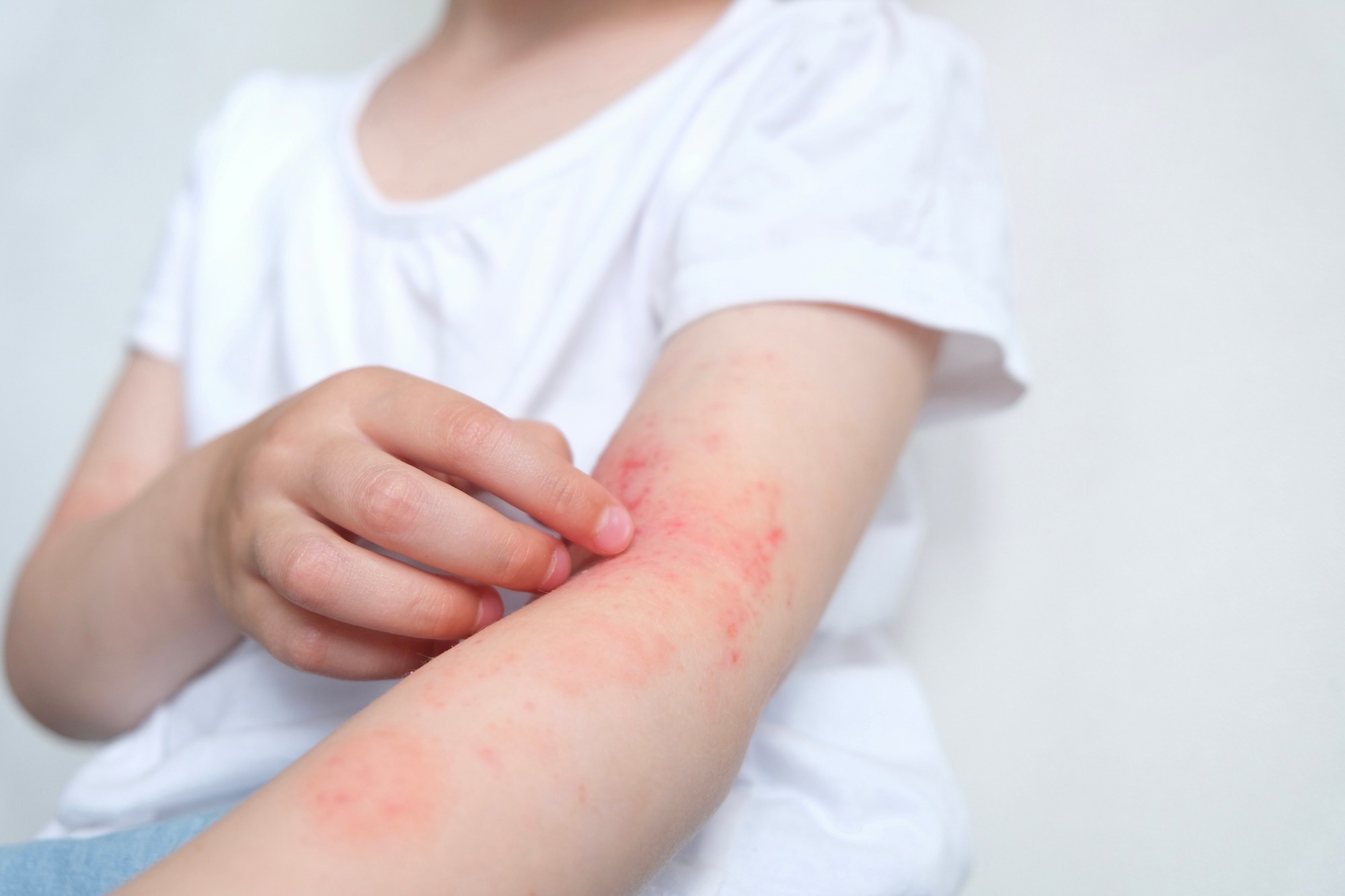In a current examine printed within the journal Vitamins, researchers in Australia investigated the potential relationship between neonatal vitamin D ranges and longitudinal eczema growth as much as age 25. They discovered that greater neonatal vitamin D ranges correlated with lowered odds of early-onset persistent eczema and elevated danger of early-onset-resolving eczema.
 Research: Neonatal Vitamin D and Associations with Longitudinal Modifications of Eczema as much as 25 Years of Age. Picture Credit score: marishkaSm / Shutterstock
Research: Neonatal Vitamin D and Associations with Longitudinal Modifications of Eczema as much as 25 Years of Age. Picture Credit score: marishkaSm / Shutterstock
Background
Atopic dermatitis, or eczema, is a typical inflammatory pores and skin ailment which will end result from immunologic disturbance and dysfunction within the pores and skin barrier, whereas its underlying pathophysiology stays unclear. Proof means that vitamin D ranges in youth could play a task within the growth of eczema. Vitamin D deficiency and eczema prevalence are greater in areas with much less daylight. Vitamin D receptors in immune cells counsel its involvement in modulating immune responses. Proof from cohort research suggests a hyperlink between greater wire blood vitamin D ranges and lowered danger of eczema in early childhood. Nevertheless, scientific trials on ladies with vitamin D supplementation throughout gestation have yielded inconsistent outcomes. Present pointers don’t universally suggest such supplementation resulting from restricted proof on its results on allergic ailments in offspring.
Regardless of recognizing totally different eczema phenotypes, no research have explored the affiliation between longitudinal eczema growth or phenotypes and neonatal vitamin D or 25(OH)D3, its most secure circulating kind. Due to this fact, researchers within the current examine aimed to discover how neonatal serum 25(OH)D3 ranges relate to eczema prevalence at numerous ages between 1 and 25 and eczema phenotype as much as age 25 years.
Concerning the examine
The Melbourne Atopy Cohort Research (MACS) adopted 223 infants with a household historical past of allergic ailments, together with self-reported bronchial asthma, allergic rhinitis, eczema, or extreme meals allergy, from start to 25 years of age. The infants had Australian-born mother and father and excessive socioeconomic statuses. Knowledge assortment included phone surveys, scientific examinations, and pores and skin prick testing (SPT) at 6 months and 1, 2, 12, 18, and 25 years. At age 18, individuals consented to entry their new child screening playing cards for measuring neonatal 25(OH)D3 ranges through dried blood spots (DBS).
Prevalent eczema was outlined based mostly on parental or self-reports of eczema analysis or rash handled with topical steroids. Longitudinal eczema phenotypes have been recognized utilizing latent class evaluation, ensuing within the following subclasses: early-onset-resolving eczema, early-onset persistent eczema, mid-onset-resolving eczema, mid-onset persistent eczema, and minimal/no eczema. Eczema/sensitization phenotypes have been decided based mostly on eczema and allergen (cow’s milk, egg white, peanut, home mud mite, cat dander, and ryegrass) sensitization, with individuals categorized into atopic eczema, non-atopic eczema, asymptomatic-sensitized, or asymptomatic teams at every age.
Statistical evaluation concerned utilizing logistic regression fashions, odds ratios, generalized estimation equations (GEEs), chance ratio exams, Wald exams, directed acyclic graphs, and sensitivity evaluation.
Outcomes and dialogue
The height prevalence of eczema was discovered to be in infancy (31.2%), declining to fifteen.9% at age 6 years and rising to 26% at age 25. The median sera-adjusted degree of 25(OH)D3 for the DBS samples was discovered to be 32.5 nmol/L. Per expectations, a big affiliation was noticed between vitamin D ranges and the start season (p < 0.001), indicating that kids born in winter had decrease 25(OH)D3 ranges. Within the sensitivity evaluation, adjusting for start season, greater neonatal vitamin D ranges have been related to lowered eczema danger at 1–2 years. Maternal smoking throughout being pregnant was discovered to switch the affiliation. Additional, greater neonatal vitamin D degree was discovered to be related to a lowered eczema danger at age 2 years in individuals with maternal smoking historical past, as in comparison with these with out it.
 The neonatal vitamin D (25(OH)D3) degree in 223 MACS individuals. The median degree was 32.5 nmol/L. P25 was 21.6 nmol/L, P75 was 44.7 nmol/L, and imply was 35.9 ± 18.6 nmol/L.
The neonatal vitamin D (25(OH)D3) degree in 223 MACS individuals. The median degree was 32.5 nmol/L. P25 was 21.6 nmol/L, P75 was 44.7 nmol/L, and imply was 35.9 ± 18.6 nmol/L.
Larger neonatal vitamin D ranges have been discovered to be linked to a lower within the danger of early-onset persistent eczema (aMOR = 0.74), in addition to a rise within the danger of early-onset-resolving eczema (aMOR = 1.30) in comparison with minimal/no eczema subclass as much as age 12 years. Comparable traits continued for eczema phenotypes for as much as 25 years. Mom’s birthplace influenced the affiliation— elevated neonatal vitamin D ranges have been linked to lowered odds of early-onset persistent eczema as much as 12 years in kids with non-Australian/New Zealand-born moms however not for these with Australian/New Zealand-born moms. Paternal training and maternal prenatal smoking have been additionally discovered to switch the affiliation with eczema phenotypes as much as 25 years.
The examine is strengthened by its management for numerous confounding elements and potential design. Nevertheless, the examine is restricted by its small pattern measurement, attrition over time, potential for lowered precision in estimates, and low generalizability past high-allergy-risk cohorts.
Conclusion
In conclusion, the examine signifies that elevated neonatal vitamin D ranges may probably decrease the chance of early-onset persistent eczema, topic to potential modifications by maternal smoking throughout being pregnant and birthplace. Additional observational research in various populations are essential to validate these findings. Moreover, well-designed scientific trials are warranted to discover the effectiveness of maternal vitamin D supplementation in stopping eczema, significantly early-onset persistent instances.
Journal reference:
- Neonatal Vitamin D and Associations with Longitudinal Modifications of Eczema as much as 25 Years of Age. Zeng R. et al., Vitamins, 16(9):1303 (2024), DOI: 10.3390/nu16091303, https://www.mdpi.com/2072-6643/16/9/1303
